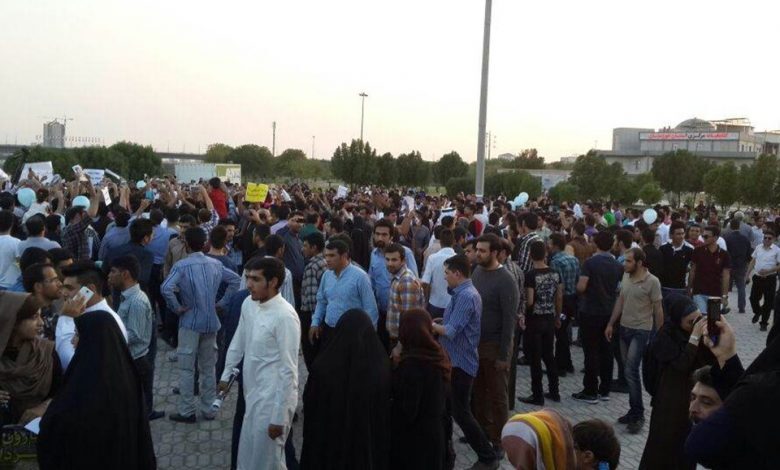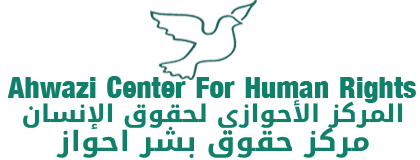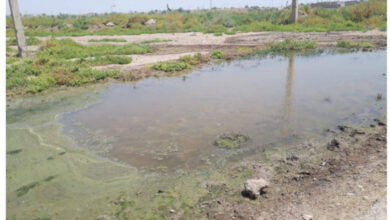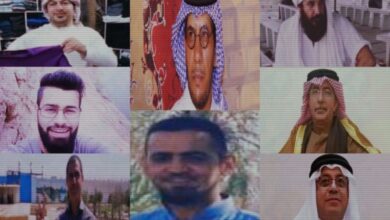Iranian regime intensifies persecution of Ahwazi activists as environmental devastation grows

Iranian regime forces are intensifying their brutal crackdown on Ahwazi human rights activists and environmentalists, especially as the activists raise the alarm over the increasingly devastating environmental effects of the regime’s sugarcane initiative.
The regime has stepped up its arrests and prosecutions of activists over their exposing the regime’s loss-making domestic sugar industry, which is destroying the natural environment. In addition to upstream damming and diversion of the Arab region’s rivers, most of whose waters are now transferred to other areas of Iran, the regime has also continuously expanded its network of sugarcane plantations along the river banks downstream which require vast amounts of water, as well as building sugar-refining plants on the river banks, using the rivers’ remaining water for irrigation and in the refining process, with the toxic chemicals used in this process, including bleach, being pumped back into the greatly reduced rivers’ waters after use; this toxification, coupled with the increased salinity from the greatly reduced water flow, makes the rivers’ waters increasingly poisonous, killing marine life and local plant, bird and animal species, while leaving much of the remaining water supply undrinkable, even by livestock.
This is further exacerbated by the pollution from the oil and gas fields and refinery complexes across the Ahwaz region, which contains over 95 per cent of the oil and gas reserves claimed by Iran, that pump out atmospheric and groundwater pollution round the clock.
For the sugarcane industry, as for the oil and gas industry, the regime displaced many thousands of Ahwazi farmers, fishermen, and villagers who lived in the areas where the plantations and refineries were established, who were given no warning or compensation for the destruction of their homes and confiscation of their lands, being left destitute and forced to move to ghettoes on the edges of regional cities or to move to other areas. As well as causing worsening water shortages downstream, the loss-making sugarcane project and its additional pollution of the rivers’ remaining waters, which are the only water source for hundreds of thousands of Ahwazis, have also devastated the environment, with many describing the ecological destruction as a deliberate act of ecocide.
The regime has responded to all protests over the catastrophic effects of its policies on the Ahwazi people and environment by arresting the activists and environmentalists, who are treated as ‘traitors’ for daring to criticise the regime.
The Iranian regime adds insult to the incessant injury inflicted on the indigenous Ahwazi people by refusing to employ them in the sugarcane industry, as in the regional oil and gas industry, instead offering high salaries and relocation bonuses to citizens of Persian ethnicity, who are viewed and treated by the regime as being racially superior to the country’s minorities; these settlers are provided with subsidised homes in specially built, heavily guarded ethnically homogenous settlements provided with amenities and facilities not available to the indigenous Ahwazi people, who are forbidden from entering them. This racist policy and attempt to effect demographic change has been promoted by regime officials in leaked communications which led to massive protests in Ahwaz previously; rather than acknowledge the people’s right to grievance, the regime sent its forces to assault and detain the protesters.
These efforts by the regime to change the demographic composition in the Arab region have led to large numbers of openly racist Persian settlers, especially in cities like Susa (Shush) and Toster (Shushter), attempting to depict the indigenous Arab population as minorities in their own towns and cities and to suggest they, the Persian settlers, are the actual natives there. Any complaint or retaliation by Ahwazis at this horrendous injustice and provocation results in the Ahwazis being arrested and brutalised by the regime’s security forces.
The devastating consequences of worsening aridification in Ahwaz
Water resources are essential for all terrestrial life, central to biodiversity, to maintaining ecosystems, and playing a fundamental role in determining every aspect of human history, culture, and societies, whether agricultural or industrial, being key in determining economic factors – without water, society and thus the economy grind to a halt. In most countries, water resources are valued and carefully managed to ensure the prosperity of agriculture, rural development, industry and energy. However, the water resources in Ahwaz are subjected by the Iranian regime to systematic and environmentally ruinous policies, which change their course via river-damming and diversion programmes to redirect them towards Persian cities; these policies have led to ecological and societal catastrophe in Ahwaz, drying out agricultural lands, causing widespread pollution and worsening the already severe impoverishment of the indigenous Ahwazi people.
While the Ahwaz region contains more than 40% of Iran’s water resources, millions of Ahwazis are deprived of any share of their most precious natural resource wealth due to the Iranian regime redirecting most of the water from the region’s rivers to other areas of Iran and refusing to provide safe drinking water to the population. The same policy also makes the regime complicit in exacerbating the existing poverty, deprivation, unemployment, marginalisation and migration among Ahwazis by destroying the agricultural sector which most of the indigenous population is dependent on. According to recent reports, 1.2 million of Ahwazi’s economy is directly related to agriculture.
The vast water resources in Ahwaz, such as large rivers, whose annual flow totals around 26 billion cubic metres , should give the Arab region in the south and southwest Iran far greater importance than it’s currently granted in the field of environmental, nutritional and economic stability in the Arabian Gulf region through the presence of around 3 million hectares of agricultural land with unique potential. The misuse and diversion of Ahwaz’ precious water resources are also directly related to climate change in the region, with fears growing over the growing environmental crisis wracking the region caused by increasing aridification and desertification caused by the regime’s massive program of dam-building and river diversion, which poses a serious threat to the ecosystem in Ahwaz itself and to the Arabian Gulf more broadly.
Ahwaz’ water resources are primarily from the region’s rivers such as the Karoon, Karkheh, Dez, Jarahi and Tammimeyah, with the alluvial wetlands downstream also serving as a vital resource influencing the regional economy and climate, providing a suitable habitat for a wide range of plant life, wildlife and birds, as well as controlling floods and replenishing groundwater reserves, as well as providing irrigation and livelihoods for generations of farmers and fishermen, and providing recreational facilities. Ahwaz currently has more than 48 wetland habitats. Five of these are registered as international wetlands, with the Ramsar Wetland Group including Falahiyeh, Hor Al-Azim, Khor Khoran, Hillah and Bamdaj wetlands.
In addition, the destruction of natural habitats and the discharge of untreated and toxic municipal, industrial, and agricultural waste directly into these waters lead to horrendous pollution of the remaining rivers, lakes and wetlands, rendering much of the water unusable. These increasing pressures on water resources undermine water security and contribute to environmental and societal consequences’, including food and economic insecurity in Ahwaz.
Environmental consequences
Along with the construction of numerous immense dams and a vast network of pipelines upriver diverting most of the freshwater supply to other areas of Iran, another of the other major factors contributing to the environmental degradation in Ahwazis the establishment of oil and gas fields in the wetlands along with the associated infrastructure of roads and transport networks.
One of the environmental consequences that threatens Ahwazi society and the natural environment due to these mostly manmade problems is the plummeting quality of the remaining water supply. According to Iranian sources, the water quality of the Karoon River – the largest river in Ahwaz and Iran has decreased by about 250% to 260% in recent years. As a result of the greatly reduced water flow caused by the upstream dams, the Karoon river now faces many grave challenges such as drought, sewage influx, and numerous environmental problems.
Iranian regime sources recently announced that the water flow of the Karoon River in the Ahwaz White Bridge area has fallen to less than 210 cubic metres per second, with Mohammad Darwish, head of the Environment Committee of the UNESCO Chair for Social Health, warning that “this figure is very worrying and will lead to social strikes.” Darwish further warned “If the Karoon’s flow falls to less than 150 cubic metres per second, it will be very likely that salty water from the Arabian Gulf enters the orchards during the season fashion and brings a major economic and environmental disaster to areas of north Ahwaz, such as Gosba and Falahiyeh.” “In addition, massive volumes of untreated raw sewage and other toxic waste is discharged directly into the Karoon; while this was balanced in previous years simply by the quantity of fresh water being sufficient to wash the toxic substances away, the current dangerously low levels magnify the dangers from them, not only for the human population but for the plant and animal life of the Ahwaz region Plain. As Mohammed Darwish warned, “In the long run, this will lead to the formation of dust production centres, the reduction of biodiversity and the intensification of migration from the Ahwaz region.”
The drying up of Ahwaz’ rivers caused by the Iranian regime’s damming and diversion program has also adversely affected the ecosystem of the wetlands, one of the most important water sources in the region, which provide many beneficial services to humans, marine life and wildlife that no other ecosystem can provide. Some of these valuable services or functions include maintaining and improving water quality, providing habitats for fish and wildlife, storing floodwaters, maintaining water flow, and absorbing pollutants in order to protect the environment. There is no doubt that the environment of these wetlands is fully connected with the Ahwazi water resources, such as rivers.
The Karkheh River is the primary freshwater source feeding the marshlands, specifically the Hor Al-Azim. However, the construction of dams on the Karkheh River has exposed the marsh to the danger of severe aridification. As a result, from 1973 to 2018, official data indicate that the wetlands area shrank dramatically, losing nearly two-thirds of its total area going from 311,642 hectares to approximately 130,133 hectares in 45 years.
Rainfall records from 1991 to the present indicates that in most of the past 30 years to date, the amounts of rain pouring into the Karkheh River basin from the upstream have increased year-on-year. This underlines that the shrinking of wetlands is not caused by any lack of rainfall or other weather conditions, making it absolutely certain that the phenomena created by the Iranian regime are the source of the gradual and accelerating desertification of the Ahwazi wetlands, such as the Hor Al-Azim. This steady aridification has led to increasingly frequent sandstorms, which were previously rare in the Ahwaz region. Meanwhile, air pollution from the oil and gas refineries exacerbates the harmful effects of these storms, mixing the sand with toxic particles and creating a poisonous atmospheric soup. Iranian Meteorological Organisation figures indicate that sandstorms have risen sharply since 2005.
The native flora and fauna still clinging on in and around the remaining marshlands are heavily polluted with various chemicals, mainly from the untreated atmospheric and groundwater waste from the oil and gas fields and refineries, as well as the toxic chemical runoff from the sugarcane refineries that the regime has built on Ahwazi rivers, which is poured into their waters without any treatment. The chemicals found in tests on water and plant samples from the area include lead, copper, arsenic, uranium, chromium, cadmium and cobalt, all of which are toxic to humans and other species at high levels. While trace amounts of these chemicals are not harmful and are found in every substance, including food and drink, the degree of their concentration makes all the difference, with the level of these chemicals found in the wetlands being far higher than the estimated safe level set by the WHO. With arsenic, for example, the World Health Organisation sets the acceptable level for groundwater as 0.01 milligrams per litre. The global average for arsenic in water is 1.8 mg per litre. However, samples taken from the marshes show that the level of arsenic has reached an astonishing and lethal level of 6,983 mg per litre.
As to copper, the WHO sets the acceptable level at 0.05 mg per litre of water. The average level globally average is 55 parts per million (ppm). In the Ahwaz marshland, this rises to a toxic 146 ppm. Similarly, with lead, the WHO acceptable rate for water is 12.5 ppm. In the marshes, the samples tested had a lead level of 1,602ppm. The global rate of cadmium is 0.2 ppm; in the marshlands, it’s 42 ppm. With cobalt, the global rate is 25 ppm; in the marshlands, it is 407 ppm. The average global level of chromium in the water supply is 100 ppm; in the marshlands, it is as high as 419 ppm. Finally, the average rate of lethal uranium is 2.5 ppm; the sample in the marshlands was almost double that at 4.2 ppm.
As all these alarming figures underline, the Iranian regime’s policies are the main reason for the increasing environmental disaster in Ahwaz through creating desertification, drought and greenhouse gases. According to the regime’s own Tasnim news agency, air pollution in the Ahwaz region is rapidly increasing and approaching a critical stage. In 2013, the World Health Organisation ranked Ahwaz as the most polluted city in the world. According to the WHO, the amount of air pollution in Ahwaz was 372 micrograms per cubic metre , 18 times the permissible limit. According to Iranian sources, around 1,000 tons of toxic pollutants are produced daily in the city of Ahwaz, leading to level of pollution so intense that even rain does not help in reducing it. On the contrary, the combination of raindrops and polluting particles that accumulate in the skies over Ahwaz, under the influence of the phenomenon of temperature inversion, increases pollution and sometimes chemical poisoning of the city’s residents to the extent that over 12,000 people were transferred to hospitals due to shortness of breath and poisoning in 2015 after the fall of the autumn rains.
Cultural consequences
While the terrible toll of the marshlands’ drying up, water pollution, desertification and dust-storms can be seen in all forms of wildlife and marine life, the effects on the region’s people have been no less devastating, leading to worsening poverty among the already marginalised indigenous Ahwazi population as the traditional sources of income are lost, as well as causing debilitating disease due to pollution and dust storms, and mass displacement, with many forced to flee their ancestral lands just to survive. The civilisation and culture of the people of the marshlands area, which date back millennia, are being steadily driven into extinction, along with the fish, birds, animals and plant life.
Migration from the Ahwaz region to other regions in Iran is one of the social crises threatening Ahwaz, again as a result of the devastation to the rivers and wetlands from Iran’s policy of river-damming and diversion. Professor of Geopolitics at Kharazmi University in Tehran, Murad Kaviani, noted that “the transfer of water from Ahwaz caused the migration of the people of this province towards the central regions such as Tehran, Karaj, Qazvin and the coastal cities overlooking the Caspian Sea.”
Kaviani told ISNA News Agency that “The issue of climate change in Iran has manifested itself in two ways, one is the decrease in rainfall, and the other is the increase in temperatures.” He added that this caused the transfer of water from Khuzestan to the central regions during this period has had a terrible, destructive effect on Ahwaz due to the drying up of water resources.
Security Consequences
These environmental consequences have had a serious impact in turn on the societal situation for the Ahwazi people through the displacement of countless thousands from their residential areas. The environmental situation also has security consequences on Ahwazis because the environmental situation threatens the water wealth in Ahwaz, which has a vital role in providing food and environmental security in the Ahwaz region, which is known as the breadbasket of Iran and ranks first in agriculture amongst all Iran’s provinces. This once again underlines the crucial role of water wealth in the livelihoods and economic well-being of many Ahwazi citizens, with the income of much of the population dependent on agriculture, which in turn depends on water resources.
In recent years, serious problems in the field of agriculture and horticulture have become the norm in all seasons in Ahwaz, with this situation having serious consequences for citizens’ livelihoods and wider economic wellbeing. For example, the problem of lack of water for irrigation of downstream palm orchards in Karoon in recent years and the lack of summer planting permits have threatened the economy of many rural families.
According to Iranian reports, the residents of about 600 Ahwazi villages in the Ahwaz region are suffering from an acute crisis in obtaining drinking water and water for agriculture, with a number of other villages in other parts of the Ahwaz region also suffering from a severe drinking water crisis. In addition, these sources indicated that the water crisis has also expanded to urban areas such as Ahwaz the capital city and Abadan, where it’s become a direct threat to citizens’ livelihood in rural and urban areas in the Ahwaz region.
According to official sources, up until the mid-1990s the water in Hor Al-Azim was up to ten metres deep, with the height. bushes that grew around it reached 13 metres until the mid-1990s. However, at present, the lands of the marsh have been drained in order to build oil and gas platforms there and of course have been additionally the construction of dams. Therefore, this situation led to the economic collapse of the local population, whose economy is linked to agriculture, livestock, fisheries and handicrafts. Furthermore, the drying of the wetland has also caused the spread of dust and pollution in most of Ahwazi cities. Thus, the health of citizens is now threatened by deliberate drought.
It should be noted that the damage is not limited to agriculture; but also includes other issues such as the depletion of groundwater resources in the Ahwaz region, the rapid and dangerous destruction of natural cycles in terrestrial ecosystems, and the increase in desertification, as a large number of citizens have been displaced from their residential areas to other areas. Thus, the environmental consequences threaten the security and stability of citizens by affecting their local economy, the spread of pollution in water and air, and desertification, where the health and economy of many citizens are endangered.
According to Iranian sources, the population of Rofayyah town before the revolution in 1979 was between 10,000 and 12,000. Now, its population is less than 5,000, with the rest of its citizens migrated towards the city of Ahwaz, the capital, or other cities due to the lack of job opportunities in their town. The leading economy of the population was agriculture and livestock such as buffaloes farming and fishing, where the citizens used to catch more than 60,000 tons of fish in the marsh, but the drying of the rivers led to the drying of the wetland and the spread of poverty and pollution in the region.
Hoshang Hassonizadeh, a water expert and university lecturer, joined the chorus of warnings over the growing environmental crisis, saying, “ the Ahwaz region is one of the most important plains in Iran in terms of land, soil quality and fertility, which can be produced 2-3 times a year due to its climatic characteristics.” The natural flow of water, the breadth and fertility of the soil, and climatic diversity turned this region into a fertile plain. Hassonizadeh noted: “If agricultural planning is used correctly, the Ahwaz region can provide a lot of agricultural products in Iran.” Of course, the river-damming and diversion projects from the Karoon and Des rivers, along with the social and environmental impacts on the discharge conditions and water quality downstream, hydroelectric power generation, reduced crop yields, and the health of water structures such as marshes due to draining and dam construction have seriously affected the security and economic stability of Ahwazis. He added that “we should not be ignorant of the negative effects of water transfer on the environment, production and industry in Khuzestan province.”
Conclusion
To conclude, the Ahwaz region has a vital strategic importance due to its abundant natural wealth in water resources. These environmental and economic assets mean that Ahwaz and its waterways should play an essential role in providing environmental stability, food and economic security. For example, wetlands can protect the environment in the region.
Tehran’s policy of river-damming and diversion, sending water from the Karoon and the other Ahwazi rivers towards the Persian cities, and constructing dams in order to drain the Ahwazi water wealth have led to disastrous results in draining the marshes, destroying fertile lands and spreading dust and pollution, with these conditions in turn leading to the deterioration of the security situation in the field of economy and health among the Ahwazi citizens. It is worth noting that criticism against the Iranian regime’s policy of building dams has increased widely, with many environmentalists believing that these dams seriously impact the region’s environment. A number of other experts also rejected the Iranian regime’s claims about the fair division of water resources, saying: “There is no excess of water in Ahwaz, as the region is facing a severe water crisis, and Since the marshlands have disappeared, agriculture, fishing, and livestock production have since become unsustainable. With no economic prospects in sight, the marshland’s inhabitants have been forced to migrate, leaving behind their villages and homes. Despite now being largely depopulated, the marshlands once hosted many villages, which have now been evacuated. Iran’s deliberate environmental destruction is to blame for the consequent spikes in cancer and lung disease, as well as soaring temperatures now defining Ahwaz.”
The Iranian regime’s policy of stealing Ahwaz’ water resources has already had devastating environmental consequences in the Ahwaz region, affecting the livelihoods and food security of the already impoverished indigenous people. Thus, although Ahwaz is rich in water resources, the vast majority of its population suffers from a water crisis as well as a critical lack of drinking water, leading many people to migrate to other areas. There is no doubt that the continuation of the current policy will lead to the emigration of the residents of more than 600 villages from their rural areas, with environmental consequences having a disastrous effect on security, and on economic and social stability in the Ahwaz region.
By Kamil Alboshoka and Rahim Hamid
Kamil Alboshoka is an Ahwazi expert in international law and Human rights. He tweets under @KAlboshoka
Rahim Hamid is an Ahwazi author, freelance journalist and human rights advocate. He tweets under @Samireza42.




